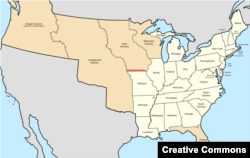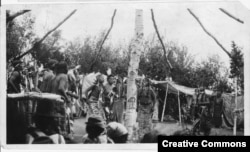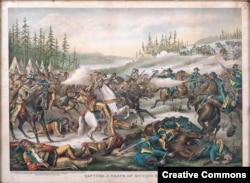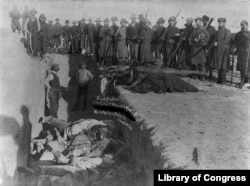Editor’s note: November is Native American Heritage Month. First proclaimed by President George H. W. Bush in 1990, it is an opportunity to acknowledge the histories and cultures of Native people across the U.S., highlighting the challenges they have faced, their sacrifices and their contributions.
“Native Americans have influenced every stage of America's development,” noted President Donald Trump in his October 31, 2017 proclamation. “They helped early European settlers survive and thrive in a new land. They contributed democratic ideas to our constitutional framers. And, for more than 200 years, they have bravely answered the call to defend our Nation, serving with distinction in every branch of the United States Armed Forces.”
This month, VOA will highlight prominent Native Americans and their role in U.S. history, culture and society.
Sitting Bull was born around 1831, a member of the Hunkpapa band of Lakota. The location of his birth is disputed. Most historians say he was born in what is today South Dakota. His descendants cite Montana as his birthplace.
Mentored by his uncle, a healer and spiritual leader, the boy killed his first buffalo at age ten and at 14, distinguished himself during a raid on the Lakota’s traditional enemy, the Crow. He earned the warrior name Thathanka Iyotake, translated as “Sitting Bison Bull.”
Sitting Bull was accepted into at least two warrior societies, the Midnight Strong Heart and Kit Fox, brotherhoods whose members were bound by principles of bravery, generosity and morality. He would also become a wichasha wakan, a spiritual leader whose visions would help guide his people.
By the end of the 1840s, the U.S., then just 25 states, extended only as far the continent’s midpoint. The Plains, considered inhospitable, were designated as “Indian Territory.” But everything changed in 1849, when gold was discovered in California, and President Polk decided it was America’s “manifest destiny” to push U.S. boundaries all the way west to the Pacific Ocean.
In 1862, the government passed the Homestead Act, handing out free 65-hectare (160-acre) lots in the West, setting off an unprecedented land rush. It also authorized the first transcontinental railroad.Wave after wave of miners, railroad workers and settlers began crossing the Plains, looking to the U.S. Army to protect them from attacks by the region’s tribes, and the 1860s saw often brutal warfare by both sides.
Refused to submit
Sitting Bull first encountered the American Army in 1863, when the military mounted a broad campaign against the Lakota in retaliation for a Dakota massacre in Minnesota. He went on to lead the Lakota in many attacks on U.S. military forts, rejecting government efforts to negotiate or contain him.
Sitting Bull refused to join other Lakota bands, the Yanktonai Dakota and Arapaho Nation in signing an 1868 treaty negotiated at Fort Laramie, Wyoming. The treaty guaranteed the Lakota "absolute and undisturbed use of the Great Sioux Reservation,” including the Black Hills, sacred to Lakota, Cheyenne, Arapaho and other tribes. It held only until the discovery of gold in the Black Hills, in 1874. The government then confiscated the Hills and ordered tribes back to the reservation. Sitting Bull resisted, setting up camp along the Little Big Horn River in Montana.
In early June of 1876, Sitting Bull held a Sun Dance, a prayer ceremony in which he pierced his arms in an act of sacrifice and danced to exhaustion. During the ritual, he is said to have had a vision of a military defeat of many soldiers.
That same month, General George A. Custer, a former Civil War hero, led a surprise attack on Sitting Bull’s camp. The Lakota, said to be inspired by Sitting Bull’s vision, fought fiercely. Within hours, Custer and more than 200 soldiers were dead, news that shocked Americans and caused the Army to redouble efforts to contain the tribes.
In video below, Sitting Bull’s great grandson Ernie LaPointe talks about his ancestor and the Battle of Little Big Horn.
Sitting Bull and his followers fled to Canada, but scarce food resources led him to finally surrender to the U.S. Authorities sent him to the Standing Rock Agency in North Dakota, where he lived as a prisoner, refusing to renounce his traditions and spiritual beliefs. This created tension among those Lakota who had embraced assimilation into Christian culture and likely led to his death.
Ghost Dance
The late 1880s saw the birth of a spiritual movement which promised that if Natives lived a good life and performed a ceremonial Ghost Dance, their former way of life would be returned to them.The prophecy spread across the Plains, where it was adapted by the Lakota, now living in harsh conditions on the reservation, dependent on inadequate government rations.
The government viewed the dance as an act of sedition and tried in vain to stop it. Sitting Bull, say his descendants, merely tolerated the prophecy, which was to his eyes a preferable alternative to Christianization
On December 16th, 1890, tribal police, acting on the government’s behalf, entered Sitting Bull’s cabin to arrest him. He was shot and killed in the melee that followed. On the 29th of December, the Army launched an attack on about 300 Lakota men, women and children camped at Wounded Knee Creek on the Pine Ridge Reservation, killing most of them and burying them in a mass grave.
Today, Sitting Bull’s descendants still pray for their ancestor, whom they revere as a visionary acting not only on behalf of his contemporaries but future generations of Lakota. And every December 29, Lakota gather at Wounded Knee to remember their ancestors and celebrate their resilience.














